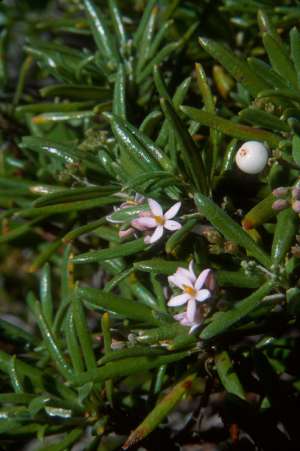Plants of South Florida · Plants by Conservation Area · Plants by County · Plants by Habitat Quick Search · Advanced Search |
||
|
|
||
 |
Strumpfia maritima Jacq. Pride-of-Big-Pine |
|
|
South Florida Status: Critically imperiled. Three occurrences in two conservation areas (National Key Deer Refuge; Sugarloaf Hammocks), and one non-conservation area (Grassy Key Pride-of-Big-Pine Site). Taxonomy: Dicotyledon; Rubiaceae. Habit: Shrub. Distribution: Native to South Florida and the West Indies. South Florida Distribution: Monroe County Keys. South Florida Habitats: Coastal berms, pine rocklands, and the rocky transition zone between pine rocklands and salt marshes. Protection Status: Listed as endangered by FDACS and as critically imperiled by FNAI. Aids to Identification: Scurlock (1987) has color photos; Nelson (1996) has a color photo; Chafin (2000) has illustrations and a color plate; the IRC Website has a color photo. References: Chapman, 1883; Small, 1933a; Long & Lakela, 1976; Correll & Correll, 1982; Scurlock, 1987; Nelson, 1996; Wunderlin, 1998; Chafin, 2000; Coile, 2000; Liogier & Martorell, 2000. Synonyms: None. Historical Context: John Loomis Blodgett first collected pride-of-Big-Pine between 1838 and 1853 on Big Pine Key (s.n., NY). It has been collected on Big Pine by numerous botanists since that time. At least one population exists in the National Key Deer Refuge at the edge of a pine rockland. This population has been vouchered a number of times (e.g., Orzell & Bridges 15968, FTG, USF). U.S. Fish and Wildlife Service biologist Tom Wilmers estimates that there are fewer than 100 plants at this station (personal communication, 16 February 2001). Allan H. Curtiss made a collection in the late 1800s at “Shore of key in Sugar-loaf Sound” (1124, NY). Francis W. Pennell vouchered a station on Sugarloaf Key in 1917 (9593, US). In 2000, Bradley and Woodmansee observed several colonies on coastal berms in Upper Sugarloaf Hammocks, within the Florida Keys Wildlife and Environmental Area (1289, FTG; 1301, FTG). George N. Avery also observed some of these colonies in the 1960s (Avery’s Notes). In 1909, John Kunkel Small and Joel J. Carter collected pride-of-Big-Pine on Grassy Key in 1909 (3115, NY). A population still occurs on Grassy Key at the privately owned Grassy Key Strumpfia Site. Bradley and Wayne Hoffman observed plants there in 1998. Small made a single collection on Upper Matecumbe Key in 1912 (3913, NY) and Harold N. Moldenke made a single collection on Little Torch Key in 1930 (816, NY). No plants are thought to be extant on either island. Avery reported a number of other un-vouchered stations that either he or others observed (Botanical Notes of George N. Avery). In 1963, Frank C. Craighead reported to him that he had seen the species “years ago” on the east end of Bahia Honda Key and on Vaca Key. No recent reports from Bahia Honda Key are known, despite a significant amount of botanical activity. In 1963, Avery observed plants on the Saddlebunch Keys (Avery’s Notes, 30 August 1963) and on the southern end of Cudjoe Key (Avery’s Notes, 22 November 1963). Kruer (1992) also reported an occurrence on Cudjoe. In 1964, Avery observed plants in “deep lagoon hammock” on Summerland Key (Avery’s Notes, 11 February 1964). Cudjoe Key, Saddlebunch Keys, Summerland Key, and Vaca Key should be surveyed. Major Threats: Exotic pest plant invasions; habitat destruction at Grassy Key Strumpfia Site; sea-level rise; coastal erosion on Sugarloaf Key. Recommendations: • Survey Cudjoe Key, East Summerland Key, Saddlebunch Keys, and Vaca Key. • Map and monitor known stations on a regular basis. • Acquire Grassy Key Pride-of-Big-Pine Site. Update: Recent population estimates by Keith A. Bradley indicate that there are more than 3,000 individuals in the Florida Keys, thus changing its status to imperiled in South Florida. Citation: Gann, G.D. 2006-2012. Species Account Update, Floristic Inventory of South Florida Database Online. The Institute for Regional Conservation. Delray Beach, Florida. |
||



